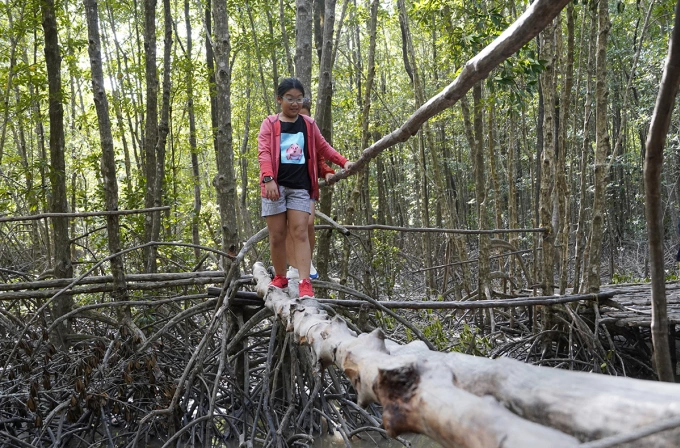Edition: International | Vietnamese
© Copyright 1997 VnExpress.net. All rights reserved.

Departing from the Cape Ca Mau National Park dock, a high-speed boat carrying five passengers traverses a channel for about a kilometer before slowing and entering a smaller watercourse. This stream leads to a mangrove forest with brackish water and heaps of shrubs. It is one of the main ecotourism attractions in nature-rich Dat Mui Commune, the southernmost point of Vietnam, located 100 km from the center of Ca Mau Town, capital of Ca Mau Province.
The boat slowly makes its way into the forest, its passengers excitedly marveling at the sight of the muddy coast and towering mangroves. The ambiance is peaceful with occasional birds chirping and endless thickets of trees. Hanging above the water, some branches sprout from decade-old trunks to form eye-catching shapes while trunks measuring over a few dozen meters provide shade.
After a few turns at a comfortable pace for tourists to enjoy and capture the view, the boat speeds up and exits the forest maze.
What greets them next is a large floodplain. Here, the boat slows again as the wind picks up. From afar, passengers can distinguish the foaming waves that lap the riverine plain. The small boat quickly berths at a mid-channel rest stop made of Nipa palm leaves and trunks. Indeed, this is the most unique spot along the Mekong River, where alluvial ground expands by 80-100 meters each year.
"The air is so fresh with slight humidity from the sea. We are taking advantage of this before returning to the city," said Le Son Ha, a tourist from Dong Nai Province whilst standing in a hut contemplating the gorgeous mangrove forest far away.
The boat continues its journey and brings its passengers to a second stop amongst dense thickets of mangroves. As the group gathers in a wooden cabin to ‘check-in’, they notice a children nearby having fun on ‘monkey bridges’. These wooden passageways spanning streams are hand-built using Rhizophora Apiculata branches, a rare hybrid species of mangrove. "I’ve only seen monkey bridges in movies, my first time crossing one was quite scary but fun," said one of the kids.
 |
|
A young girl crosses a rare "monkey bridge" amid the dense mangroves. |
After an hour’s boat trip covering 20 km, the captain brings the group of tourists back to their respective homestays.
At 7 p.m., Dao Van Tai, a tourist from Ho Chi Minh City, along with his wife and son head down to the river channel for a swim after a shower and dinner. For this purpose they are each handed a pair of thick gloves and a head flashlight.
While on the canoe, the homestay host briefly explains the characteristics of three-striped crabs as well as ways to cook them. Once the boat reaches a designated shrub, the host signals his guests to keep quiet before turning the canoe. Behind the thicket of shrubs, a purple three-striped crab large as a human wrist appears. The host quickly catches and drops it in a bucket.
The tourists are then given individual instructions on how to catch the crab and the chance to do so. The evening hunt wraps up with almost a dozen crabs in hand.
"I’m very impressed with my first visit to Dat Mui. The landscape is beautiful, its natural resources bountiful and intact, its people friendly and helpful. I even got to catch crabs at night and listen to chamber music," said Dao Van Tai.
This ecological tour providing the opportunity to explore mangrove forests and sleep at local homestays has been running for a year, involving about ten local households. The cost of a trip varies from VND700,000 ($30) for a group under five to VND1 million ($43) for a group of six to ten.
To add value to these travel packages, homestay hosts go above and beyond to organize unique nightly expeditions such as fishing, oyster digging, and crab, shrimp, or mud creeper hunting. Numbers show that last year alone, Cape Ca Mau National Park, the world’s 2088th Ramsar site welcomed over 300,000 visitors to its 41,000 hectare realm.
There’s an old saying from this southernmost province that goes: "Avicennia trees go first, then Rhizophora apiculata" (both derive from the mangrove species). Whilst the two represent the intertidal land, sturdy Avicennia trees pave the way for the latter to thrive with its abundant roots hardening the floodplain. Once the land is stable enough, fruits grow out of Avicennia trees and Rhizophora apiculata sprout. These trees nourish themselves on new alluvial soil and quickly takes over the space. This causes Avicennia to weaken and wilt. Their seeds fall, germinate, new roots bud and the cycle restarts.
Truong Van Se, vice chairman of Dat Mui Municipal People’s Committee, said every local can learn something from this pattern, especially if we want to preserve and protect nature.
Dat Mui Commune has 3,400 households sustained by fishing. In recent years, fishing profits have decreased while the population steadily increased, making it harder for most Dat Mui inhabitants to survive.
As the sacred southernmost point of the country, visitors don’t solely travel to Dat Mui to see its shrubby mangrove forests but also to ‘check in’ on social media. They typically pick national coordinate landmark GPS 0001 on Cape Ca Mau, often described as a boat arch, as their check-in location, much like Hanoi Flagtower in the capital or the end of Ho Chi Minh Highway. At most, some sign up for tours in the forest.
However, local administrators believe the land holds more potential and hope to improve Dat Mui’s tourist image.
In addition to local campaigns against forest exploitation, officials are discussing the development of community-based tourism. The idea is to erect homestays, restaurants, souvenir shops, and create a long-term income for locals.
"When the majority of a population is employed, general income flow is relatively stable, they will become more environmentally conscious," said Se.